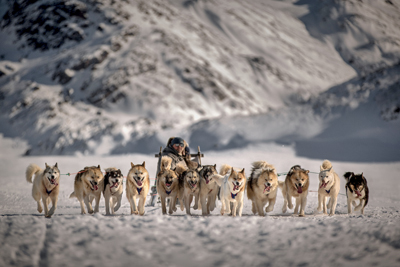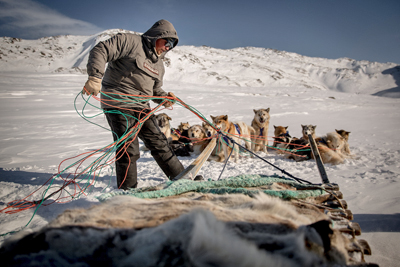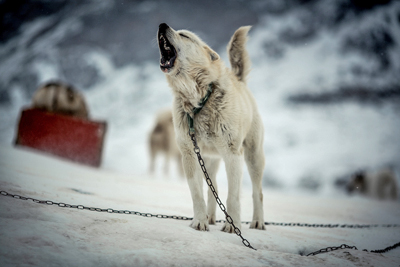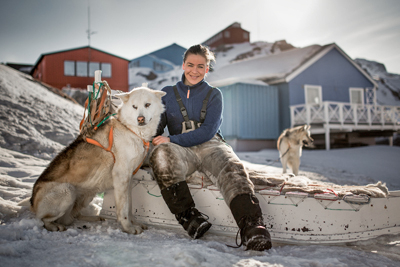From the Editor
Passage - Siu-Ling Han
Passage - Benson E. Ginsburg
Building & Testing Astrup's Dog Sled
The Arctic Nomads Project
Zacharias Kunuk’s Latest Film
The Chinook Project’s 2016 Wellness Clinics in Canada’s North
Canadian Inuit Dogs I have owned, raised and trained: a photo essay; Part 4
Book Review: Padlei Diary
Index: Volume 18, The Fan Hitch
Navigating This Site
Index of articles by subject
Index of back issues by volume number
Search The Fan Hitch
Articles to download and print
Ordering Ken MacRury's Thesis
Our comprehensive list of resources
Defining the Inuit Dog
Talk to The Fan Hitch
The Fan Hitch home page
Editor: Sue Hamilton
Webmaster: Mark Hamilton
The Fan Hitch, Journal
of the Inuit Sled Dog, is published four
times a year. It is available at no cost
online at: https://thefanhitch.org.
The Fan Hitch welcomes your letters, stories, comments and suggestions. The editorial staff reserves the right to edit submissions used for publication.
Contents of The Fan Hitch are protected by international copyright laws. No photo, drawing or text may be reproduced in any form without written consent. Webmasters please note: written consent is necessary before linking this site to yours! Please forward requests to Sue Hamilton, 55 Town Line Rd., Harwinton, Connecticut 06791, USA or mail@thefanhitch.org.
This site is dedicated to the Inuit Dog as well as related Inuit culture and traditions. It is also home to The Fan Hitch, Journal of the Inuit Sled Dog.
The Fan Hitch welcomes your letters, stories, comments and suggestions. The editorial staff reserves the right to edit submissions used for publication.
Contents of The Fan Hitch are protected by international copyright laws. No photo, drawing or text may be reproduced in any form without written consent. Webmasters please note: written consent is necessary before linking this site to yours! Please forward requests to Sue Hamilton, 55 Town Line Rd., Harwinton, Connecticut 06791, USA or mail@thefanhitch.org.
This site is dedicated to the Inuit Dog as well as related Inuit culture and traditions. It is also home to The Fan Hitch, Journal of the Inuit Sled Dog.

Team of dogs bringing a driver and his guests back towards Sisimiut in Greenland.
photo: Mads Pihl, Courtesy Visit Greenland
The Arctic Nomads Project:
an interview with Pipaluk Lykke Løgstrup
Pipaluk Lykke Løgstrup was born 1976 in Narsaq, Greenland. She is a qualified primary and lower secondary school teacher majoring in pictorial art and English, and holds an M.A. in Cultural and Social History from Ilisimatusarfik, University of Greenland. She has been employed in projects for Qeqqata Municipality, and in 2014 she opened her own company, NEBULA. NEBULA works with culture in so many ways: books, films, art exhibitions and events like the Arctic Nomads. Pipaluk is also a fashion editor for the Greenlandic magazine Arnanut and a member of the board of The Nordic Institute in Greenland.
TFH: What is going on in the world of the traditional aboriginal Greenland Inuit Dog? Do Greenlanders still have a great interest in the use of dog teams for traditional purposes? For ecotourism?
PLL: Less and less people are keeping a dog team. It is becoming expensive, and you can no longer own a dog team and make a living from the hunting anymore. Therefore you must keep a dog team only if you can afford the food and the equipment. I hope that we can sell more trips for tourists.
TFH: What inspired you to undertake this Inuit Dog symposium?
PLL: Less and less people own a dog team in Sisimiut. When I grew up there were dog teams all around town, and you would hear them all the time, and there would be puppies to play with everywhere. We basically grew up surrounded by sled dogs, and we learned from a very young age how to identify the state of a loose dog: if it was aggressive or friendly, and we learned to keep the dogs at a distance if they looked suspicious. Today, only a few dog teams are still in the town, and those dogs that are still in use have been moved to a location outside of the town. People in Sisimiut were annoyed with the noise the dogs made. The city council received complaints from citizens. People felt that their children were in danger of being bitten or eaten by the sled dogs, and the town management needed space to build homes. So the dog is no longer a vital part of community any more the way I see it. With this I sense that we are losing knowledge of nature, knowledge of snow conditions, ice conditions, and also a healthy bond between humans and sled dogs. Also an important part of the sled dog community is the material culture - how to construct a strong dog sled, make whips from seal skin, how to make a good harness for the dog, and the like. This knowledge, I think, is important to us as a people, and also as being a part of the world – to show that we have understood the conditions nature gave us with this arctic environment, and that we indeed adapted to those and harnessed its powers with ingenuity and grace.

Dog sled driver from Sisimiut, Greenland untangling ropes and preparing
his team of dogs after a break on a trip near Sisimiut in Greenland.
photo: Mads Pihl, Courtesy Visit Greenland
TFH: Please describe the scope of the planned symposium.
PLL: The symposium is a two-day event set at Taseralik Cultural Center in Sisimiut. The focus is three: The past, the present, and the future of the Inuit dogsledding culture. We have presenters that will illuminate these three different angles on the dog sled, and a programme is coming together. For example we hope that The National Museum in Greenland will give a presentation on the past: archeological dog sled and sled dogs; where and when does the earliest traces of the dog sled occur. This could be parts of dog sleds, or sled dog bones etc. The present: a status on where we are today, statistics on the number of dogs; the municipal plans for the sled dogs. We would also like to hear about the municipal policy on the issue. Is this something that we want to keep as a living part of our culture and history? The national organisation of dogsledders, KNQK, is also participating, and we feel that that makes a strong foundation for the bearers of this special culture of dogsledding. They are well organised and are deeply rooted in Greenland. They know so many dogsledders throughout our country. The future: trying to see if we can place dog sledding as a future base of income. Is there a way to make money from it? Can owning a dog team be a business, such as for example, eco-tourism in the form of shorter or longer expeditions into the wild, hunting trips by dog sleds? Also very important is that we will hear from local Inuit dog sled drivers who have created successful businesses in tourism. We start the whole symposium with a seven-day dog sled building event where each group will build a dog sled that represents the dog sleds from their area. The finished sleds will be handed over to the Museum of Sisimiut afterwards. But first we will have a test drive of the dog sleds, which hopefully will be fun!
TFH: Who are the expected participants?
PLL: Twenty skilled and respected Inuit dog sledders from Chukotka, Canada, and Greenland. Also a number of scholars, biologists, anthropologists and the like are attending the symposium giving presentations and sharing what they know.
TFH: What are some of the topics and what does the symposium hope to accomplish?
PLL: We really hope that we can create a strong network between Inuit dog sledders and help to sustain the dog sledding culture, by shedding light on some possible ways of keeping the sled dog and dog sledding culture alive. We want to create pride in the dog sledding culture, and hopefully get a whole bunch of kids to want to start their own dog teams all over the Inuit communities. Also we want to document the dog sledding culture as it is today, and get an understanding of the state of this culture as it exists now throughout the Inuit communities. We are not accustomed to meeting with our fellow Inuit, across the boarders of our nations - Russia, Canada and Denmark. We hope to strengthen the bond between us. Our cultures and common history are so closely related, and our life styles and language are similar.
TFH: What will be the languages spoken?
PLL: Russian, English, Greenlandic, Danish and different Inuit dialects.
TFH: What are the dates?
PLL: Dog sled building event: November 26 to December 3. Symposium: December 3 to December 4.

Sled dog from Sisimiut, Greenland barking.
photo: Mads Pihl, Courtesy Visit Greenland
TFH: Can anyone come or is this just for participants?
PLL: People are welcome to join and listen at the symposium, but unfortunately we cannot pay any expenses guests might have, and we are fully booked on speakers.
TFH: Will there be special travel and accommodation rates for attendees?
PLL: No.
TFH: How does one get to Sisimiut from North America or Europe?
PLL: You either fly via Copenhagen Airport or Iceland to Kangerlussuaq International Airport in Greenland. From there you take a smaller plane to Sisimiut.
TFH: Can you describe for those who may be interested in attending something about Sisimiut and Taseralik, the place where the symposium is to be held?
PLL: Sisimiut is the next largest city in Greenland. Around 4,700 people live here. It is placed a few kilometers north of the Arctic Circle, and we are the southernmost city in Greenland that has sled dogs. We have the largest body of landmass in Greenland between us and the Ice Sheet, which gives good opportunity for hunting and for hiking. Sisimiut is a thriving community with two elementary schools, a high school, a mining school, a construction school and a school for arctic engineers. Also we have a special school for our national costume, that was established when we were slowly losing the skills needed to produce a traditional national costume in Greenland. The main income is from fisheries, and we have the largest fish factory in Greenland. Our town is powered by a hydropower plant. People in Sisimiut are known for not taking no for an answer and to do things instead of waiting for others to do them for us. We are closely related to nature - many people hunt and fish in their spare time, we spend time in nature during all seasons. Many of us enjoy winter with excellent landscape for both cross country skiing and alpine skiing, snowmobiling and of course dog sledding. We annually host the three-day cross country skiing event, the Arctic Circle Race, which is an extreme challenge for both pros and hobby skiers; and we have a Nordic and Greenlandic music festival called Arctic Sounds Festival. Taseralik is a cultural center placed in the very heart of the town, on the shore of the Nalunnguarfik Lake. Taseralik hosts art exhibitions, theatre and dance shows, and is movie theatre, a conference centre and a café.
TFH: Where can one learn more and follow the progress of the conference plans?
PLL: Check out the Arctic Nomads website.
TFH: Will symposium proceedings (print or DVD) be available to view or purchase for those who cannot attend?
PLL: I am afraid not. But we expect to have a media reporter during both the dog sled building event and the symposium.
TFH: In what way can people who are not able to attend still be supportive?
PLL: They can visit the project’s web page and click the purple button to make a donation.

Dog sledder Navarana Lennert from Sisimiut with one of her dogs in
downtown Sisimiut, Greenland.
photo: Mads Pihl, Courtesy Visit Greenland
TFH: What inspired you to make this film NAVARANA – The Dogsledder?
PLL: Navarana is the daughter of our neighbours, and she is a graceful and strong young woman. I knew she was a good dog sledder and that she was a real nature enthusiast. She is a hunter and loves being outdoors. She used to be a physical instructor for young snow boarders, loves to water ski and the like. Navarana is really good with the dogs and her dogs are good. She’s good with people, too. She drives tourists. Her family is one of the last families that still has a place for their dog team in the city. She takes care of the dogs together with her father. Of course, I should make a film about her!
TFH: When do you hope to have the film completed and how will it be distributed?
PLL: We hope it will be finished in 2018. We expect it to be shown at film festivals and maybe televised in Greenland. Let us see what the future holds.
* *
*
About Sisimiut; How to get there; Where
to stay
If you are interested in attending the Arctic Nomads Conference, there are three additional websites in particular you should visit:
It may be a good idea to have a face-to-face with a professional travel agent to help with travel arrangements.All about Sisimiut
How to get to Sisimiut: From North America, travelers must first fly to either Reykjavik, Iceland or Copenhagen, Denmark.
Where to stay in Sisimiut